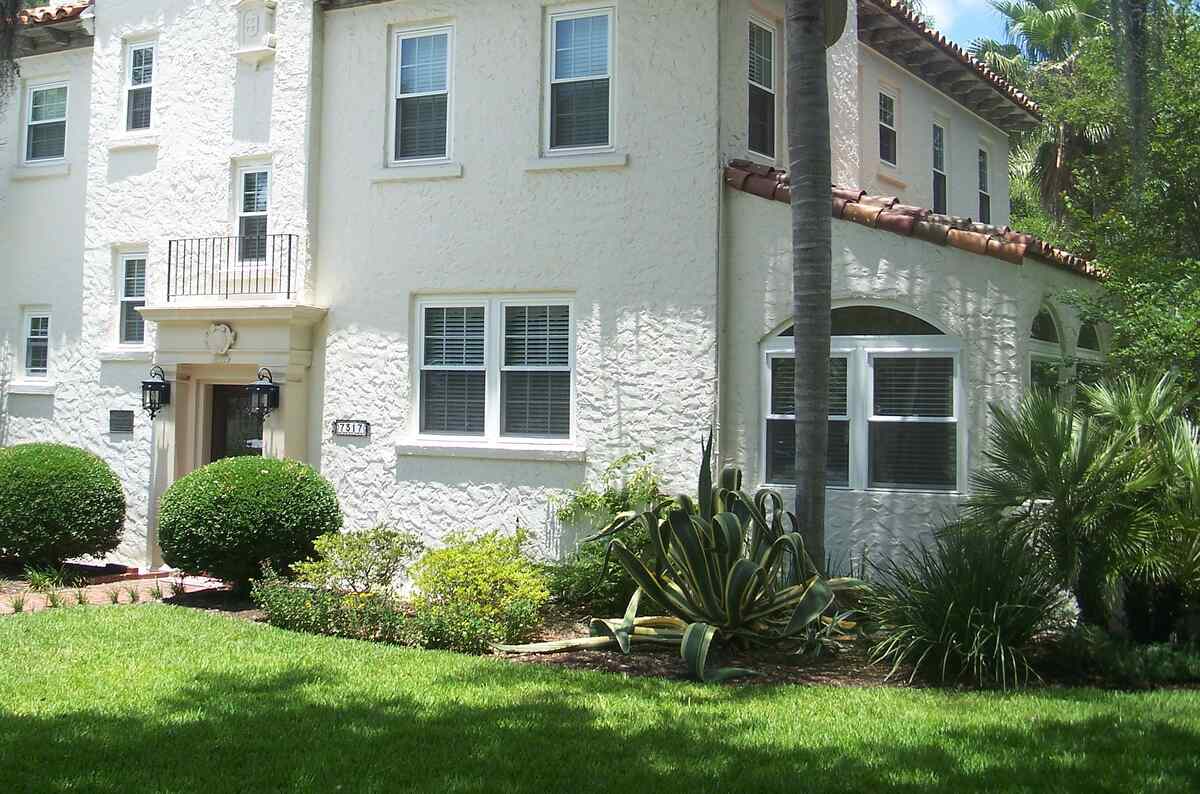
While Jacksonville’s warm climate limits you to only warm-season grasses, you’re not left without choices. These are the 5 best grass types for your River City lawn:
Having a beautiful yard begins with the right grass that can survive the conditions presented by a coastal subtropical city. These five of the most common grass types in Jacksonville have become favorites because of how well they thrive here.
1. St. Augustinegrass (Stenotaphrum secundatum)
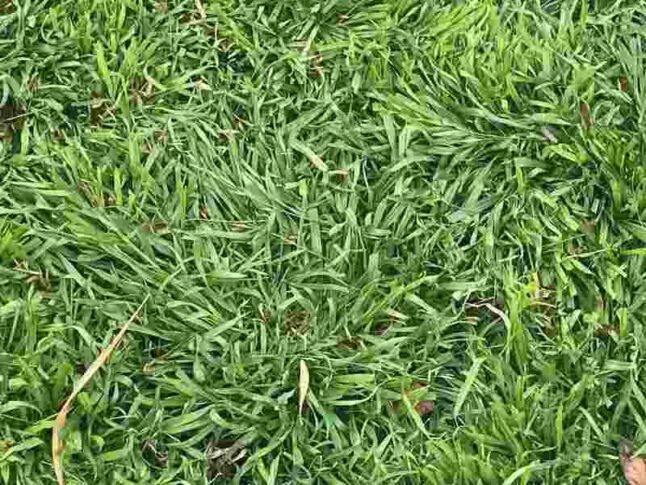
According to the University of Florida Institute of Food and Agricultural Sciences, this type of grass is the most common lawn grass planted in lawns across the Sunshine State.
Ranging from green to blue-green in color, St. Augustinegrass is well-suited for Jacksonville yards in part because of its good salt and drought tolerance. It’s also the most shade-tolerant warm-season grass, and it tolerates disease pretty well.
However, St. Augustinegrass is not the most low-maintenance grass type out there, needing frequent mowing and dethatching, as well as regular fertilization. It’s also a favorite of southern chinch bugs and can’t really handle heavy foot traffic.
In the winter, St. Augustinegrass will go dormant and turn brown. It will resume growing in the spring.
Pro Tip: If you want to introduce St. Augustinegrass to your lawn, plant it in the spring. Avoid establishing this turfgrass in the winter or summer months, and don’t fertilize it until 30-60 days after establishment.
- Spreads Through: Stolons (above-ground stems)
- Tolerances
- Shade: Moderate. Most shade-tolerant warm-season grass
- Drought: Moderate to high, but it will need water to stay green during drought
- Foot Traffic: Low
- Diseases and Pests: Moderate to High
- Maintenance Needs: Needs frequent mowing due to fast growth rate; develops thatch easily; needs regular fertilization (2-6 applications from spring to fall)
- Mowing Height: 3.5 to 4 inches
- Soil pH: 6 to 7.5
- Soil Type: Tolerates most soil types, but prefers moderately fertile, moist soil. Doesn’t like compact soils.
Grass Plug Options:
– Seed Ranch St Augustine Seville Grass Plugs (2 Trays)
– Seed Ranch St Augustine Floratam Grass Plugs (2 Trays)
2. Zoysiagrass (Zoysia species)

Although St. Augustinegrass is king in Florida lawns, Zoysiagrass is gaining more popularity among Floridians. Although it grows slowly, Zoysia grows quite dense, fine, and short.
This dark green turfgrass is also stiff thanks to the silica in its blades, making it a great option if you have lots of foot traffic on your lawn. Zoysia also is salt- and drought-tolerant.
Like many warm-season grasses, Zoysiagrass goes dormant in the winter, but it recovers a bit slower compared to other types. In general, Zoysiagrass recovers more slowly from disease and pests, too.
Zoysia is also prone to thatch development years after establishment, especially if you over-fertilize it.
- Spreads Through: Stolons and rhizomes (below-ground stems)
- Tolerances
- Shade: Moderate
- Drought: Moderate
- Foot Traffic: High
- Diseases and Pests: Good against disease, but recovers slowly. Preyed on by many Jacksonville pests, like billbugs, sod webworms, mole crickets, and white grubs
- Maintenance Needs: Medium. Benefits from spoon-feeding fertilizers in smaller quantities more frequently (3 times annually in North Florida); also develops thatch easily when overfertilized
- Mowing Height: 1 to 2 inches
- Soil pH: 6 to 6.5
- Soil Type: While some cultivars tolerate various soil types, Zoysiagrasses typically prefer well-draining soils
Grass Plug and Seed Options:
– Zoysia Plugs (50 Large Grass Plugs)
– Zoysia Plugs (50 Full & Lush Grass Plugs)
– Zoysia Plugs (100 Plugs)
– Zoysia Emerald Grass Seeds (1/8 lb. of seeds)
– Zenith Zenith Grass Seeds (1/8 lb. of seeds)
3. Centipedegrass (Eremochloa ophiuroides)
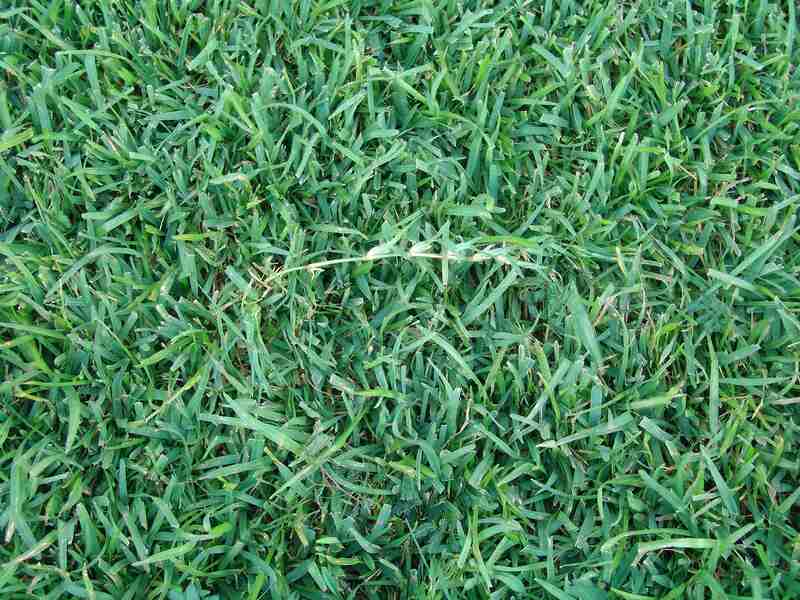
Centipedegrass is a very low-maintenance turfgrass. This lighter grass type doesn’t require much mowing, weeding, and fertilizing. It also tolerates shade fairly well.
However, centipedegrass is slow to grow and can’t handle foot traffic or salt. It also doesn’t take well to over-fertilization; avoid overfertilizing it to make it a darker green color, as it will easily develop thatch and contribute to centipedegrass decline.
Centipedegrass also has little defense against nematodes.
- Spreads Through: Stolons
- Tolerances
- Shade: Moderate
- Drought: Moderate, but goes dormant during extended drought
- Foot Traffic: Low
- Diseases and Pests: Prone to centipedegrass decline and highly susceptible to nematodes
- Maintenance Needs: Medium. Benefits from spoon-feeding fertilizers in smaller quantities more frequently (3 times annually in North Florida); also develops thatch easily when overfertilized
- Mowing Height: 1 to 2 inches
- Soil pH: 5 to 6
- Soil Type: Acidic, infertile, and moderately well-draining soils. Avoid very dense clay soils
Grass Seed Options:
– Gulf Kist Coated Centipedegrass Seeds (1 lb.)
– Scotts EZ Seed Patch and Repair Centipedegrass (3.75 lbs.)
– TifBlair Centipedegrass (5-lb. bag)
– Pennington Centipedegrass and Mulch (5-lb. bag)
4. Bermudagrass (Cynodon species)
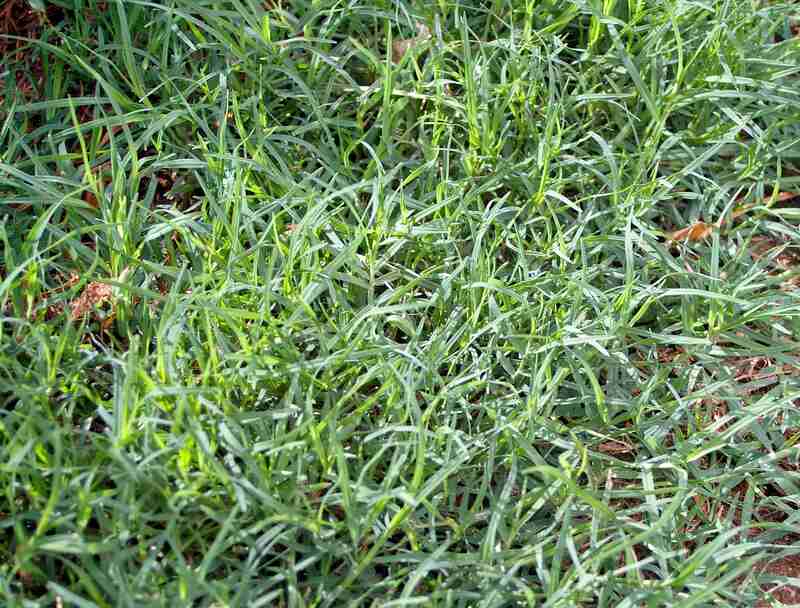
Popular in golf courses and public parks, this medium to dark green turfgrass is also a great pick for your lawn. Bermudagrass is very hardy, resisting drought, salt, and foot traffic. Originating from the African savannahs, it can also grow in poor-quality soils.
However, this turfgrass isn’t low-maintenance, doesn’t like shade, and doesn’t resist insects and nematodes very well. It’s also called “devil’s grass” because of how invasive it is. Bermudagrass can and will start growing in nearby flower beds if you’re not careful.
If you want this grass for your Jacksonville lawn, plant it during spring or early summer for the best results.
- Spreads Through: Aggressively through stolons and rhizomes
- Tolerances
- Shade: Low. Keep in full sun
- Drought: High, but goes dormant during extended drought
- Foot Traffic: High
- Diseases and Pests: Good resistance to disease, but diseases are common; low resistance toward insects and nematodes
- Maintenance Needs: Needs frequent mowing due to fast growth rate, develops thatch easily, and needs regular fertilization
- Mowing Height: ½ to 1.5 inches for hybrid cultivars, 1.5 to 2.5 inches for common Bermudagrass
- Soil pH: 6 to 6.5
- Soil Type: Tolerates most soil types
Grass Seed Options:
– Pennington Bermudagrass Bare Spot (5 lb. bag)
– Pennington Smart Seed Bermudagrass Mix (8.75-lb. bag)
– Scotts Turf Builder Bermudagrass (10-lb. bag)
– Hancock Seed Co. Bermudagrass (50-lb. bag)
5. Bahiagrass (Paspalum notatum)
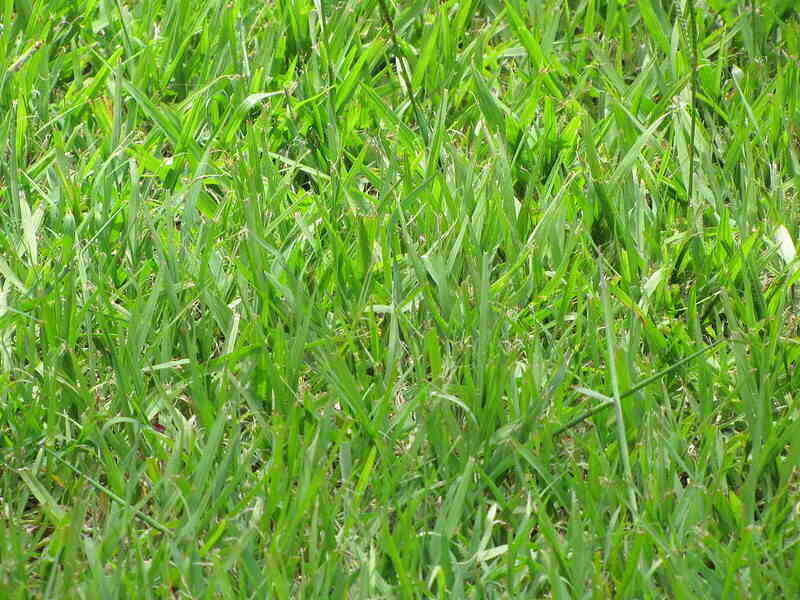
Bahiagrass is a slow-growing turfgrass that doesn’t produce a dense lawn or handle foot traffic well. However, it’s a great option for homeowners that want a low-maintenance yard, as it doesn’t need much fertilizer or water.
Bahiagrass is best for large lots without irrigation systems. It will even reseed itself if you don’t mow it.
- Spreads Through: Stolons
- Tolerances
- Shade: Low, but better than Bermudagrass
- Drought: Moderate, but will become dormant during extended drought
- Foot Traffic: Low
- Diseases and Pests: Good
- Maintenance Needs: Needs to be mowed depending on seedhead presence. Doesn’t need much fertilizer, but still needs to be fertilized 1 to 3 times a year.
- Mowing Height: 3 to 4 inches
- Soil pH: 5.5 to 6.5
- Soil Type: Performs well in sandy loam soils, but tolerates a wide range of soils, including soils with low fertility
Grass Seed Options
Pensacola Bahiagrass:
– Scotts Turf Builder Pensacola Bahiagrass (5 lb. bag)
– Hancock Seed Co. Pensacola Bahiagrass Seed (5 lb. bag)
– SeedRanch Pensacola Bahiagrass Seed (10 lb. bag)
Argentine Bahiagrass:
– Scotts Turf Builder Argentine Bahiagrass (10 lb. bag)
– Hancock Seed Co. Argentine Bahiagrass Seed Mix (25 lb. bag)
FAQ About Caring for Your Grass in Jacksonville
New lawns will need to be watered more often. In all other cases, water your grass on an “as-needed” basis. If your grass doesn’t need to be watered, then avoid watering it, as overwatering can actually lead to thatch accumulation and disease.
Of course, this is easier said than done.
Here are a few signs your grass needs watering:
● Leaf blades folding up
● Wilting
● Grass turning blue-gray
● Footprints don’t disappear after you walk on the grass
Once you see these signs, you probably need to water your lawn before it turns brown. Read our article on watering your Jacksonville lawn to learn more.
In North Florida – including Jacksonville – you should wait until April 15 before fertilizing your lawn in spring. Fertilizing season lasts from spring to fall, so your last fertilization should be around mid-September.
Fertilizing any earlier than April 15 runs the risk of fertilizer leaching, as the grass’s weakened root system won’t be able to absorb it all.
Generally, you should also wait anywhere between 30 to 60 days before fertilizing a newly planted lawn.
Not quite. Farther south, grass will grow throughout the year. North Florida, however, experiences cold temperatures in the winter that will send many warm-season grasses into a dormant state.
But don’t worry; your grass will grow again once temperatures warm up in spring.
However, this doesn’t mean you should stop caring for your lawn during the winter. In fact, it’s as important as spring lawn care. If you’re not careful, your lawn might even be hit by winter lawn diseases.
How to Keep Your Jacksonville Turf Green
Choosing the right grass isn’t where the story ends if you want a lush and beautiful lawn. Actually caring for your lawn will take you most of the way there. This includes mowing, watering, fertilizing, dethatching, and so much more.
You can do it yourself, but you can also save yourself the trouble by hiring a lawn care professional.
With a LawnStarter lawn care pro doing your yard work, you can sit back, relax, and enjoy your beautiful lawn. Connect with a Jacksonville lawn care pro today!
LawnStarter participates in the Amazon Services LLC Associates Program, an affiliate advertising program. LawnStarter earns revenue from products promoted in this article.
Main Image Credit: Jax FL 7317 San Jose Blvd House01 / Ebyabe / Wikimedia Commons / CC BY-SA 3.0